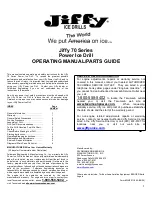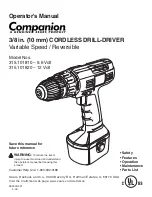
10. Use only one charger when charging.
11. Do not attempt to open the charger or the drill. There
are no customer serviceable parts inside. Return to
any authorized Black & Decker service center.
12. DO NOT incinerate the drill or battery packs even if
they are severely damaged or completely worn out.
The batteries can explode in a fire.
13. Do not incinerate the batteries. They can explode in
a fire. A small leakage of liquid from the battery cells
may occur under extreme usage, charging or
temperature conditions. This does not indicate a
failure. However, if the outer seal is broken and this
leakage gets on your skin:
a. Wash quickly with soap and water.
b. Neutralize with a mild acid such as lemon juice or vinegar.
c. If the battery liquid gets in your eyes, flush them with
clean water for a minimum of 10 minutes and seek
immediate medical attention.
MEDICAL NOTE:
The
liquid is a 25-35% solution of potassium hydroxide.
Charging the Power Pack
THE BATTERIES IN YOUR POWER PACK ARE NOT
FULLY CHARGED AT THE FACTORY. BEFORE
ATTEMPTING TO CHARGE THEM, THOROUGHLY
READ ALL OF THE SAFETY INSTRUCTIONS.
The 3-5 hours charger is designed to use standard
household power.
.
1. Put the switch control lever in the center OFF
position
(Fig. 1)
and remove power pack from the tool.
2. Plug the charger into any standard electrical outlet.
3. Insert the power pack into the charger and let it
charge for 5 hours.
4. Remove pack from the charger and replace in tool.
Important Charging Notes
1. After normal usage, your drill should be fully charged
in 5 hours or less. Your drill was sent from the factory
in an uncharged condition. Before attempting to use it,
it must be charged for at least 3 hours.
2. DO NOT charge the power pack in an air temperature
below 40°F or above 105°F. This is important and will
prevent serious damage to the power pack. Longest life
and best performance can be obtained if the power
pack is charged when the air temperature is about 75°F.
3. While charging, the charger may hum and become
warm to touch. This is a normal condition and does
not indicate a problem.
4. If the power pack does not charge properly—
(1)
Check current at receptacle by plugging in a lamp or
other appliance.
(2)
Check to see if receptacle is
connected to a light switch which turns power off
when you turn out the lights.
(3)
Move charger and
power pack to a surrounding air temperature of 40°F
to 105°F.
(4)
If the receptacle and temperature are ok,
and you do not get proper charging, take or send the
power pack and charger to your local Black & Decker
service center. See "Tools Electric" in yellow pages.
5. The power pack should be recharged when it fails to
produce sufficient power on jobs which were easily
done previously. DO NOT CONTINUE using drill with
its power pack in a depleted condition.
6. To prolong power pack life, avoid leaving the power
pack on charge for more than 5 hours. Although
overcharging is not a safety concern, it can significantly
reduce overall power pack life.
7. When the battery is inserted into the charger, the red
“Charging Indicator” light will come on indicating
that there is contact between the battery and
charger. The light will stay on as long as the battery
is in the charger and the charger is plugged into a
working outlet. It WILL NOT flash, go out or change to
a different color when the charging cycle is complete.
Safety Warnings and Instructions: Drills
1. Do not lock the tool ON when drilling by hand.
Refer to Operating Instructions-Switch.
2. Hold drill firmly to control the twisting action of the drill.
See
Figure 2.
3. When attaching accessories in the drill chuck, hand
tighten the keyless chuck firmly
WARNING:
Drill may stall (if overloaded or
improperly used) causing a twist. Always expect
the stall.Grip the drill firmly to control the twisting
action (see
Fig.2
) and prevent loss of control
which could cause personal injury. If a stall does
occur, release the trigger immediately and deter-
mine the reason for the stall before re-starting.
Operating Instructions
Switch and Control Button
A forward/reverse control button determines the direction
of the tool and also serves as a lock off button
(Fig. 1)
.
To select forward rotation, release the trigger switch
and depress the forward/reverse control button as
shown in
Figure 1, 3
. To select reverse, depress the
forward/reverse control button the opposite direction.
E N G L I S H
14


































